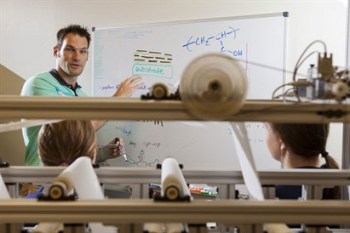Feb 1 2013
Researchers at Texas A&M University have for the first time made a completely organic nanobrick wall that does not allow gas to pass through it.
 Photo of Dr. Jaime Grunlan
Photo of Dr. Jaime Grunlan
Dr. Jaime Grunlan, an associate professor in the Department of Mechanical Engineering, and his research group replaced traditional, inorganic clay with graphene oxide. Graphene oxide has a carbon framework, and because it can be dispersed in water the way clay disperses, can be considered an organic clay.
The research was published in — and featured on the cover — of the Jan. 21 issue of Advanced Materials.
The graphene oxide thin films are less than 100 nanometers thick and are created with the layer-by-layer assembly technique in which the film is developed by depositing layers of graphene oxide and polymer on top of each other. And because this film was made in water, it’s environmentally friendly, too.
These films, most of which are transparent, can separate hydrogen gas from carbon dioxide with a greater selectivity that has been previously demonstrated with more traditional thin films. In fact, Grunlan said, gas separation has never before been demonstrated with these types of films and this is an important feature for the energy and packaging industries.
This could be an important discovery for membrane separation, which is used to purify hydrogen gas, for example, by getting rid of all non-hydrogen molecules.
“We tested both carbon dioxide and hydrogen,” Grunlan said. “The carbon dioxide was seemingly completely stopped, or at least was below detection levels. At most, one carbon dioxide molecule passed through for every 380 hydrogen molecules, so only the hydrogen was left behind.”
Graphene oxide is the “sexy” particle of the moment, like the carbon nanotube was a decade ago, he said. Graphene oxide is expensive right now, so his process is not commercially viable at the moment. But once graphene oxide becomes more widely available the way carbon nanotubes now are, then the cost could come down.
The technology is still in its infancy, but it could eventually benefit any industry that needs gas separation: the oil and gas industry, to purify methane; industrial gas companies, which need to purify oxygen, nitrogen, hydrogen, or other gases for research, medical or industrial use; the food packaging industry, which needs to keep gases from spoiling packaged food; and even the electronics industry, which could use the technique to develop flexible displays for smart phones and tablets.
Grunlan holds the Gulf Oil/Thomas A. Dietz Professorship, and is also a faculty member in the interdisciplinary Materials Science and Engineering Program and the Artie McFerrin Department of Chemical Engineering.
Source: http://engineering.tamu.edu